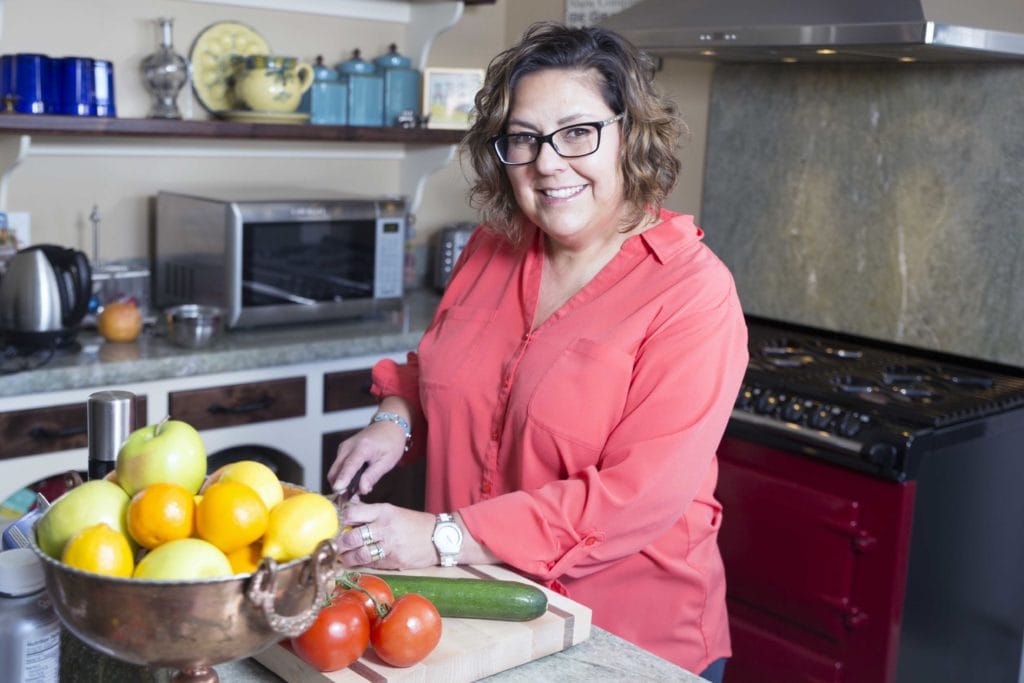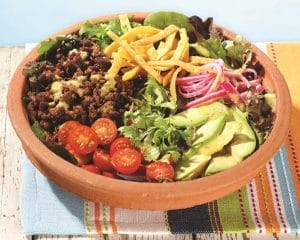
Updated August, 2021: The coronavirus epidemic has been a long, challenging time for everyone. And that especially goes for the food allergy family. Back in the spring of 2020, grocery shelves were getting wiped clean, restocked, then swiftly emptied again. It was unsettling.
Fortunately, food supply levels improved with time. But as the COVID-19 pandemic drags on in 2021, there is still no guarantee you’ll find that specific allergy-friendly product you need at the grocery store. Maybe your kids’ favorite nut-free, sesame-free bread is sold out. Or the egg-free, soy-free mayo is on back order. This is not easy when allergies or celiac disease already restrict food options.
My blog isn’t called Gratefulfoodie for nothing. I love food and experimenting with food, and I’m happy to share some shopping and cooking ideas with Allergic Living‘s followers. Consider it a kitchen rethink for coronavirus times.
As food allergy parents, no one under our watch goes hungry, rather we find that creative workaround. Let me see if I can help you with that. Let’s open our minds and our pantries and consider some new ideas. (Note: If you like the advice that follows, also don’t miss my online shopping tricks and pantry hacks in Allergic Living‘s free “COVID-19 & Allergies” digital magazine from 2020.
12 Allergy Shopping & Cooking Tips
I recommend starting with an eating plan. Shop with an eye to “cooking strategically” (see below). Let’s think this through. What most families will need is a supply of nutritious, multi-purpose allergy-friendly staples. Consider these essentials:
1. Multi-use flour mix (gluten-free and/or allergy-friendly). This is a base for pancakes, breading or muffins. For sauces and soups, don’t forget the thickening power of not only flour, but arrowroot, corn or potato starch.
2. Shelf-stable non-dairy milk alternatives are an important staple not to be overlooked. If coconut is not an allergy issue in your home, canned coconut milk is also useful to have for everything from baking to Asian cuisine cooking and homemade ice cream.
3. Allergy-friendly chicken, vegetable or beef stocks or bouillon cubes enhance the flavors of stews, soups, rice and other grains, stir-fry and sauces. In some meals, they also help to expand the number of servings.
4. Pasta is everyone’s favorite comfort food. Now a few tasty gluten-free varieties, such as Cybele’s Free to Eat, even power up the protein. Consider boxed allergy-friendly Mac and ‘Cheeze’ or pasta dinners when you need a cooking break.
5. Whole grains, quinoa and rice are filling and healthy choices – plus great bases for soups, stews, burrito bowls, stir-fry and to stretch leftovers. With oats, you can even make your own (gluten-free or regular) oat milk at home.
6. Choose allergy-friendly and shelf-stable cooking oils to replace or help preserve refrigerated and sometimes hard-to-find dairy-free spreads used in cooking or baking. Oil makes a great substitute for butter in cakes, cupcakes, breads and muffins.
7. Cut the number of grocery store trips by purchasing frozen fruits and vegetables that sub well when fresh produce is hard to find. As for the fresh, consider fruits and vegetables with extended shelf life. These include apples, citrus fruits, and potatoes. Scrumptious cobblers and crisps can be whipped up from fruits that are slightly over-ripe.
8. Allergy-friendly canned or jarred beans, soups, chili, fruit and veggies can sit on pantry shelves for a year or more. Just check that you have a can opener.
9. Applesauce makes a good snack, and is great for replacing eggs in recipes. Canned pumpkin is another clever egg replacer for baking.
10. Nut butter alternatives and jellies are food allergy family staples, so ensure you have on hand. Can’t locate at your grocery store? Then scout online (see “cooking strategically” below).
11. For easy flavoring, have salsa, hot sauce and gluten-free soy sauce available.
12. Allergy-friendly protein powders or beverages provide boosts of nutrition for snacktime, or post exercise. (You’ve got to keep that body moving.)
Cooking Strategically
Focus on recipes that are tasty when stretched. Prepare dinners that morph into lunches. For example, Monster Meatloaf Meatballs turn into a meatball sandwich or meatloaf chili.

Preserve ingredients: Instead of roasting a chicken on a bed of onions, save onions for other dishes and choose a slow-cooking recipe calling for only herbs and a lemon.
Don’t have a small freezer? This might be the time to order one. Cooking, doubling recipes, and freezing in quantities will ultimately spare you stove time. Buy freezer bags, which work better for longer freezing time.
Choose recipes that use zero-waste ingredients, such as canned garbanzo beans. The liquid from beans needed for sesame-free hummus can be used to create an interesting aquafaba dessert.
Try your hand at baking homemade cakes, loaves, cupcakes, breads and muffins. Use leftover or extra ingredients, such as berries, ripened bananas in muffins or even sautéed onion and olives in breads.
Pick recipes that double as kids’ entertainment, such as making sugar cookies, guacamole or homemade tortillas.
Put your instant pot or crockpot to work with simple and nutritious time-saving recipes. These kitchen workhorses help you dish up pastas, chicken dishes, and more.
Tricks to Food Sourcing
Can’t find your must-have brand locally or on Amazon? Check out online specialty product sites, such as Direct Eats, Food Service Direct, Vitacost or iHerb.
Plus here’s a tip: many allergy-friendly brands (e.g. Enjoy Life Foods) offer direct shipping from their websites. For cooking and baking, a brand like Gerbs offers a variety of bulk ingredients, free of 14 allergens. It’s a good time to try a new smaller brand – e.g. Zego Foods, which sells purity-tested snack bars and double protein oatmeal.
You can also speak to your local grocery manager if some foods you usually buy are missing. Some stores will take orders for specialty items, such as egg replacers. Or they may hold a restocked item for you, especially if told there’s a child with medical diet needs.
For some items, be ready to order a case and split costs with others. Bulk buying of food staples has become one of the new trends in pandemic grocery shopping.
Recipe Inspiration

Seek out hearty, tasty and filling allergy-friendly recipes. Here are a few helpful examples to get you inspired:
Three Bean Chili and Chipotle
Beef Tacos in a Bowl
Baked Beans
Quinoa Salad with Bacon & Vinagrette
Sesame Free Eggplant Hummus
Spanish Rice and Cauliflower Bowls
Zucchini Thai Noodle Salad
3 Ingredient Beer Bread (not gluten-free)
Easy Dairy-Free Cheesy Sauce
Emergency Preparedness
Always stick to your food allergy and asthma protocols. Read labels, call manufacturers and follow doctor’s orders. Ensure you have a good supply of medications.
Eleanor Garrow-Holding, CEO of the Food Allergy and Anaphylaxis Connection Team (FAACT), shares a few emergency preparedness tips:
- Keep updated food allergy and anaphylaxis emergency action plans and asthma action plans accessible with medications.
- Prepare a “go bag” in case someone with asthma or food allergies needs to go the hospital.
- Since schools have closed, if you haven’t already, contact the school (and/or school board if necessary) to request a time to pick up medications in the nurse’s office.
These are certainly challenging times, but as I said at the outset, we’re a resilient, creative community, and highly determined when it comes to keeping loved ones safe and safely fed. Keep that up. And if you feel you’re in need of support, follow Allergic Living‘s Facebook page or reach out on one of several wonderful Facebook support group pages. We’re here for each other; we can get through this together.
Caroline Moassessi is a regular contributor to Allergic Living and the founder of Gratefulfoodie.com.
Related Reading:
Allergic Living’s “COVID-19 & Allergies” Resources Hub
Allergic Living’s Food Allergy Anxiety Guide
Allergic Living’s Allergy-Friendly Recipes Section




